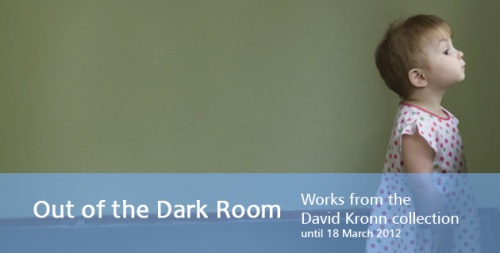 Lee Miller – self portrait in headband
Lee Miller – self portrait in headband
Ooops! Should never leave a two week gap to write up notes! I’ll see what I can drag up from my tired ol’ brain cells on this one! Anyway, back on October 14th myself and a few other CorkAP’ers attended A Short History of Photography at the Lewis Glucksman Gallery, Week 3. Presented by Chris Clarke, Glucksman Curator of Education and Collections, was The Commercial Image, and a very entertaining and informative lecture it was too.
Chris began his lecture by discussing photography in advertising, and how photography is a realistic medium that is easily mass produced. One of the first images he showed was Lee Miller – self portrait in headband (above). Lee Miller was a model who became a photographer. As her career progressed, Miller became a key figure in fashion, war photography (documenting the 2nd World War for Vogue magazine), and contemporary art, as assistant, muse and lover of surealist artist Man Ray.
 Edward Steichen – Kotex advertisment
Edward Steichen – Kotex advertisment
Miller was introduced to Man Ray by Edward Steichen for whom she modelled for Kotex. At the time this was a very controversial advertisement, as it was the first time that an advertisment for a menstrual hygiene product featured a photograph of a person. But a taboo was broken, and advertising and photography broke new ground.
 Edward Steichen – Gary Cooper
Edward Steichen – Gary Cooper
Steichen was a also cross over photographer between art and advertising, (and a war photographer during WW1). Advertising at this time (and ever since) promoted as much as anything else an aspirational lifestyle, and in photographs such as the one above, we see Gary Cooper depicted in a suave, wealthy, healthy, manner – very aspirational. That said, the difference between how men were depicted in advertising compared to women was stark enough. In both cases, very aspirational, artistic images are used, but images of women were much more objectified than those of men – “Lisa as V.O.G.U.E” by Horst P. Horst, below, being a case in point!
 Horst P Horst – Lisa as V.O.G.U.E
Horst P Horst – Lisa as V.O.G.U.E
 Robert Piguet – Brigand Perfume
Robert Piguet – Brigand Perfume
The way objects were depicted were also aspirational, sexualised, graphic. Robert Piguet’s ad for Brigand perfume is nothing short of phallic!
 blow in her face and she’ll follow you anywhere (!!)
blow in her face and she’ll follow you anywhere (!!)
Cigarette advertising was probably the most explicit in terms of aspirational advertising, with explicit sexual conoctations, emphasising the point that, really, you want these. Of course, cigarette advertising has since been banned (at least in this part of the world – is it banned everywhere?), and to modern eyes the one above for Tipalet is shocking, objectional, and, well, kinda hilarious. Did they really get away with this stuff?!
 Silk Cut advert
Silk Cut advert
By the 80’s cigarette advertising was very much curtailed, and advertisers had to become much cleverer. The advertisments became much more subliminal, pushing people on a subconcious level. The Silk Cut adverts, designed by Charles Saatchi were very clever, depicting a puple silk with a single slash in the fabric. Sublime, but not condoned!
 David LaChapelle – Evian
David LaChapelle – Evian
Art photographers used advertising as a way to sell their work, as well as the product being advertised. David LaChapelle’s work is big, colourful and garish. The scenes he depicts are very much set up, not quite realistic. His advert for Evian is selling what he does as much as it is selling water. Advertising has always been used by many art photographers as a valid platform to show their work – Jurgen Teller and his Marc Jacobs ads, Oliviero Toscani and Benetton, Ed Ruscha Absolut Ruscha, Annie Leibovitz – Keith Haring. The list goes on, art photographers selling themselves and their work as much as the products they are commissioned to sell.
 Juergen Teller – Marc Jacobs
Juergen Teller – Marc Jacobs
 Toscani – Benneton
Toscani – Benneton
 Absolut Ruscha
Absolut Ruscha
 Annie Leibovitz – Keith Haring
Annie Leibovitz – Keith Haring
It could be asked given a series of images such as these, are these photographers entirely promoting their own thoughts and ideas, or are they being influenced by their work in advertising, and is this affecting or changing how they work? Advertisers such as Benetton and Marc Jacobs are very keen to work with artists, designers, musicians and photographers. The association is seen, I guess, as mutually beneficial. Similarly, Keith Haring is an artist who alligns himself with photographers. The photograph that Leibovitz took of him definatley must have been mutually beneficial to both the artist and photographer. Of course, most photographers produce their own work as well as the commissions they do for advertisers. William Klein, a painter turned photographer, worked commercially for Vogue, and also took photos, such as “Supermarket and Gun”, which depicted the underlying conditions of the society we live in.
 William Klein – Supermarket and Gun
William Klein – Supermarket and Gun
….
At the end of the lecture (which didn’t end there, but it’s gone too late to write anymore! ), Chris set us all a task, dividing us into groups and electing people to speak. It was a bit of a jolt to those of us who expected to sit and listen, but it was fun to partake, think a bit about what had been discussed, and have a bit of banter back and forth. All in all a great couple of hours. Tomorrow evening is lecture number 5, The Photographer as Artist. Looking forward to it!
– Rory
















